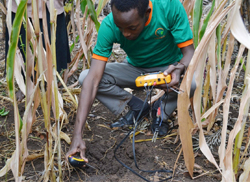
Smallholder farmers in the Rift Valley and Western Kenya have seen their yields grow by up to 60 percent thanks to precision farming techniques.
Dubbed precision farming, or micro-dosing, the process involves the application of small, affordable quantities of fertilizer with the seed at the time of planting or as a top dressing 3 to 4 weeks after the seed sprouts.
This ensures that the tender crop utilizes the fertilizer exhaustively, in sharp contrast to spreading fertilizer over the field, which means many crops compete for the same portion of fertilizer sprayed.
Rather than asking how a farmer can maximize yields or profits, micro-dosing asks how a farmer can maximize the returns on a small initial investment- that might grow over time, turning deficits into surpluses.
Farmers who use micro-dosing apply 6 gram doses of fertilizer, about a full bottle cap or a three finger pinch, in the hole where the seed is placed at the time of planting. According to the International Crops Research Institute for Semi-Arid Tropics (ICRISAT), this translates to about 67 pounds of fertilizer for every 2.5 acres.
This technique, the research institution says, uses only about one-tenth of the amount typically used on wheat. Unfortunately, the Kenyan crops are so starved of nutrients, such as phosphorous, potassium and nitrogen, that even this micro amount often doubles crop yields.
Farmers in various areas of the country where micro-dosing is taking shape have also adopted innovative techniques to apply micro-doses of the appropriate fertilizer. While farmers in Rift Valley use fertilizer measured out in an empty soft drink or beer bottle cap, in Central Kenya the farmers measure the fertilizer with a three finger pinch and apply in it the same hole in which the seed is sown.
Where soil is hard, farmers dig small holes before the rain starts, then fill it with manure, if available. When rains begin, they put fertilizer and seeds in the hole and the soil provides a moist environment, encouraging root growth, and the water is captured instead of running off the hard-crusted soil. By correcting soil deficiencies for essential nutrients with tiny doses, root systems develop and capture more water, increasing yields. According to ICRISAT, land degradation affects more than half of Africa, leading to loss of an estimated $42 billion in income and five million hectares of productive land each year. The majority of farmlands produce poor yields due to poor farming techniques, nutrient deficiency and lack of water.
Land degradation is particularly acute in sub-Saharan African regions where long-term overuse of soil and low, unpredictable rainfall are prime reasons for poor food production. The farmers are so poor they take everything they can out of the soil and are not willing to invest in fertilizer because the growing season is very risky.
The failure to replenish the soil fuels an unrelenting, vicious cycle. Unless nutrients are replaced, soils are depleted and yields and crop quality decline, leading to widespread hunger and under nutrition.
Unable to feed their families or afford to buy food, farmers abandon unproductive land to clear forests and plough new land, and the cycle repeats. Clearing new lands for farming is blamed for an estimated 70 percent of the deforestation in Africa. It is this equation that is now driving the development of micro-dosing.
